Arts & Entertainment Community
Croatia Day celebrates town’s fishing heritage — and a restored netshed
Jeannette Shilley was too young to remember when she first saw the Skansie netshed.
Community Sponsor
Community stories are made possible in part by Peninsula Light Co, a proud sponsor of Gig Harbor Now.
When she was born in 1971, her Croation-rooted family’s home perched on the hillside just a block or so northwest of the Skansie brothers’ waterfront property.
“I knew the Skansie brothers,” she told Gig Harbor Now during a recent interview at the historic shed. Her face reflected delight in her memories of Antone and Vince, sons of Andrew and Bertha Skansie. They were the last private owners to occupy the pioneer family’s home, garage, yard and, of course, the netshed.
She recalls Vince, adorned with distinctive headwear, driving along local streets in his “big blue Oldsmobile…He always wore a white flattop cap. You could see him coming a mile away.”
Oldsmobile? Some remember a Cadillac. No matter.
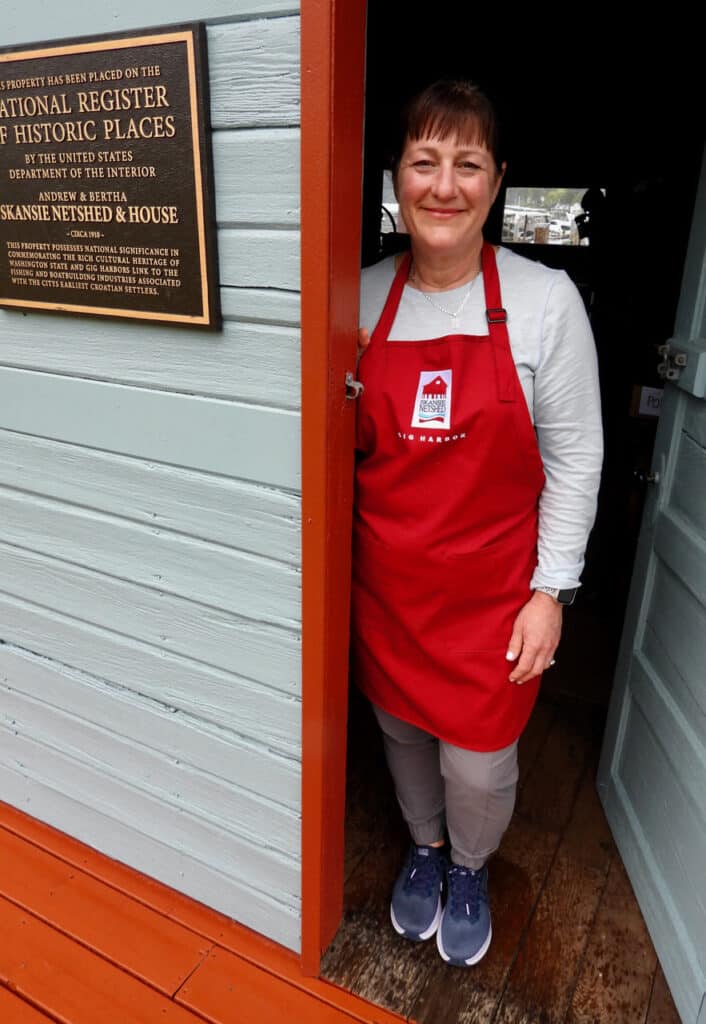
Jeannette Shilley grew up near the Skansie Netshed and knew Vince and Antone Skansie. Photo by Chapin Day
Netshed ready for the spotlight
Given her memories, her family roots, her self-expressed lifelong love of Gig Harbor — not to mention her role as a board member of the Skansie Netshed Foundation — Shilley (nee Shulich) is certain to be among those celebrating “Croatia Day” at Skansie Park on Saturday, May 31.
That’s the day when the now city-owned netshed’s rough-hewn doors are to swing open to the public for the first time in almost a year and a half, showcasing a more than $311,000 city-funded re-roofing, re-painting and structural reinforcement project.
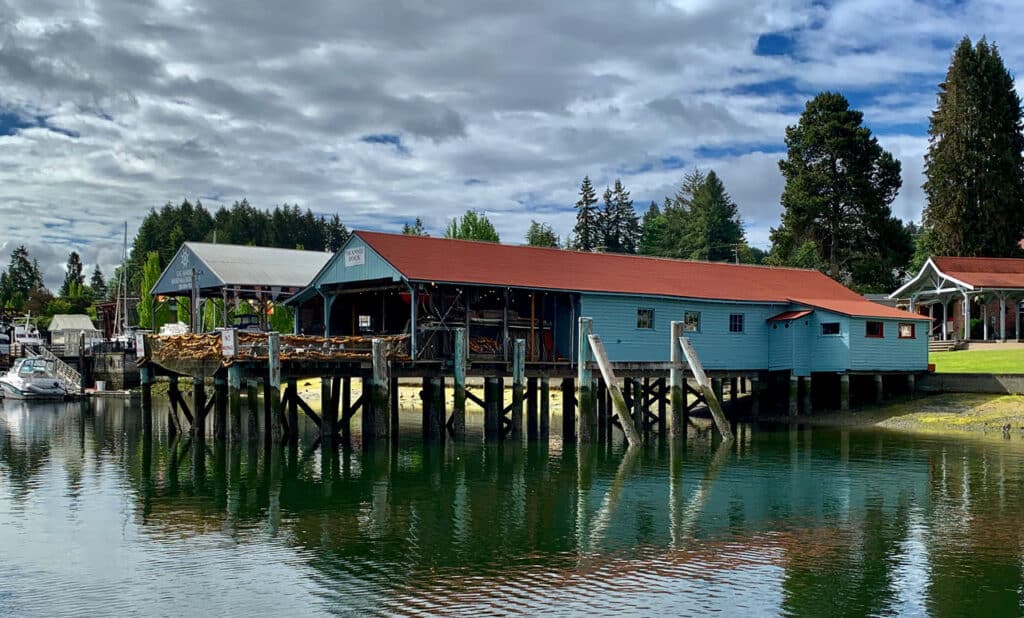
The Skansie Netshed re-opens to the public on May 31 during a Croatia Day celebration. Photo by Chapin Day
The city purchased the property from family heirs after the deaths of Antone in 2001 and Vince in 2002. They had retired from fishing in 1990. The price: A reported $2,880,000 for the almost two-acre site.
City Public Works Engineer Marcos McGraw told Gig Harbor Now last week that the work will preserve the site’s iconic 115-year-old netshed “for decades to come,” a finger-pier fingerprint left by a now fading past.
The reopening also should provide key moments in a free, afternoon-long celebration the netshed foundation has dubbed “Croatia Day,” a festival of family-friendly activities.
Croatia Day
Organizers envision a celebration of cultural, social, and economic influences that arrived in Gig Harbor with immigrants from what we now call Croatia in the later 19th and early 20th centuries and remain even today.
The festival, from noon to 6 p.m. Saturday, will include Croatian foods and crafts, a kids’ “coloring table,” teaching booths for Croatian language and songs, net-mending demonstrations and docent-led tours of the netshed.
Culturally savvy, skilled and costumed performers dot the planned schedule for Skansie Park’s pavilion, with some encouraging audience participation and offering impromptu lessons. (Few may know that they are playing and dancing on the spot once occupied by the garage where Vince housed his notable Oldsmobile — or was it a Cadillac?)
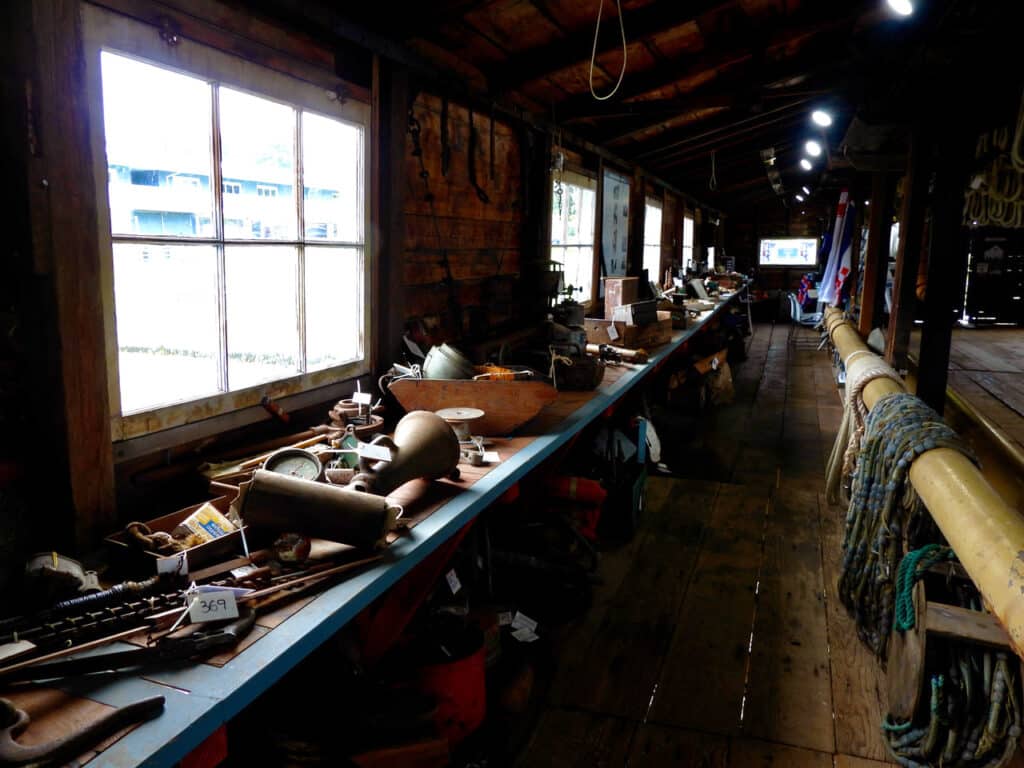
Gear on display inside Skansie Netshed. Photo by Chapin Day
Want to try a “kolo?” That’s a dance, not a soft drink. How about a “krici, krici ticek?” Pronounced: kree-chee, kree-chee, tee-chek; Translation: chirp, chirp little bird. Also a dance. (Something along the lines of hop-step-step-walk. Work on it.)
How about trying a sarma or a pasticada? (You don’t dance ‘ em. You eat ’em. Enjoy!)
Gig Harbor’s Croatian roots
While Scandinavian and other cultures significantly impacted what Gig Harbor has become, there remains little doubt that immigrants from Croatia were the stimulus for and at the core of the fishing fleet, which by the mid-20th century numbered about 30 sea-capable boats.
As Harbor History Museum Executive Director Stepanie Lile noted to Gig Harbor Now, the three Harbor men usually credited with being Gig Harbor’s original outside settlers, all were fishermen. Two of the three were Croatian and encouraged many others to make the arduous trek from the Dalmation coast to join them here.
“People,” Lile said, “tend to move to where it feels like home.”
For decades, buoyed by the local abundance of logs, lumber and Old-World craftsmen, the distinctive fishing fleet — and the shoreside businesses it stimulated — anchored the local economy. Our minuscule but weather-protected harbor had an outsize influence among West Coast fishing ports.
Netsheds
Long before Gig Harbor’s waterfront evolved into a homeport for boutiques, fiberglass yachts, tourists and retirees, netsheds punctuated more than a mile of its western shoreline.
At one time, by historians’ counts, there were 25 to 30 of them from just outside the harbor’s narrow entrance to just short of its northern end shoals. The sheds rarely sprouted from the less populated, less accessible eastern shore.
Simply put, the long, narrow sheds served to maintain their owners’ livelihoods, providing covered space for drying, storing and repairing the nets, lines, hardware, tools and other marine paraphernalia required to keep their craft fit for duty.
The 1910 Skansie netshed, credited as the harbor’s first, originally was just 20 feet long. Over the years, it was replaced, then modified, by Andrew Skansie and other family members. It grew rapidly to its present 81-foot length.
Though the city re-shingled and repainted the shed in 2004, four years later a review declared its condition to be “fair to poor.” Ensuing city work a decade ago included dozens of new pilings, roof joists and decking, and making it ADA accessible.
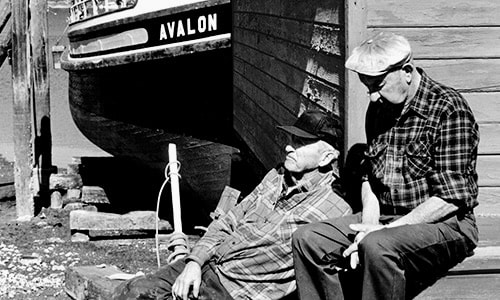
Antone and Vince Skansie rest after painting their boat, the Avalon, in 1990. Photo courtesy of Guy Hoppen
Families and fishing
Most netsheds were arrayed on docks directly behind fishing family houses. The docks jutted out on wooden pilings toward deeper water, although a few clung parallel to the shore. Some were shared among neighbors.
Judging from aging photographs, the sheds were far from elaborate or ornate. Most were simple structures reflective of their purpose and in concert with a jumbled, gritty, industrial working waterfront.
Whatever the differences in shed design, the vast majority had one thing in common: Their owners had last names ending in “ich,” a Slavic language syllable, usually indicative of “son of.”
Pioneer late 19th century Gig Harbor fishermen usually worked from small oar or paddle-powered craft that could be beached to bring a catch, gear and crew ashore.
During the 20th century, the larger, motorized fishing boats that became characteristic of the local fleet required water seven or eight feet deep to remain afloat.
Having a netshed spanning out into deeper water meant that a skipper, during appropriately high tides, could moor their craft directly to the shed, making the boat and its nets easier to load, unload, service or repair.
However, in a harbor notable for its high to low range of tides, the bigger boats needed deeper water during low tides to avoid accidentally being stuck in the mud.
Among other features, docents at the Skansie netshed often point out two solitary pilings further offshore from the shed’s outmost end. They are low tide, deeper water parking spaces called — in marine parlance — moorage “dolphins.”
Skansie Netshed Foundation
Few people keep closer track of such details and netshed history than Lita Dawn Ancich, former Gig Harbor Historic Preservation Coordinator, descendent of a pioneering fishing family, and a long-time spark plug of the Skansie Netshed Foundation and other history-saving projects.
That nonprofit foundation, which Ancich helped establish in 2015, currently finds itself halfway through a 20-year agreement with the city to manage and maintain for the public the Skansie shed, which has been placed on national, state and other registries of historical places.
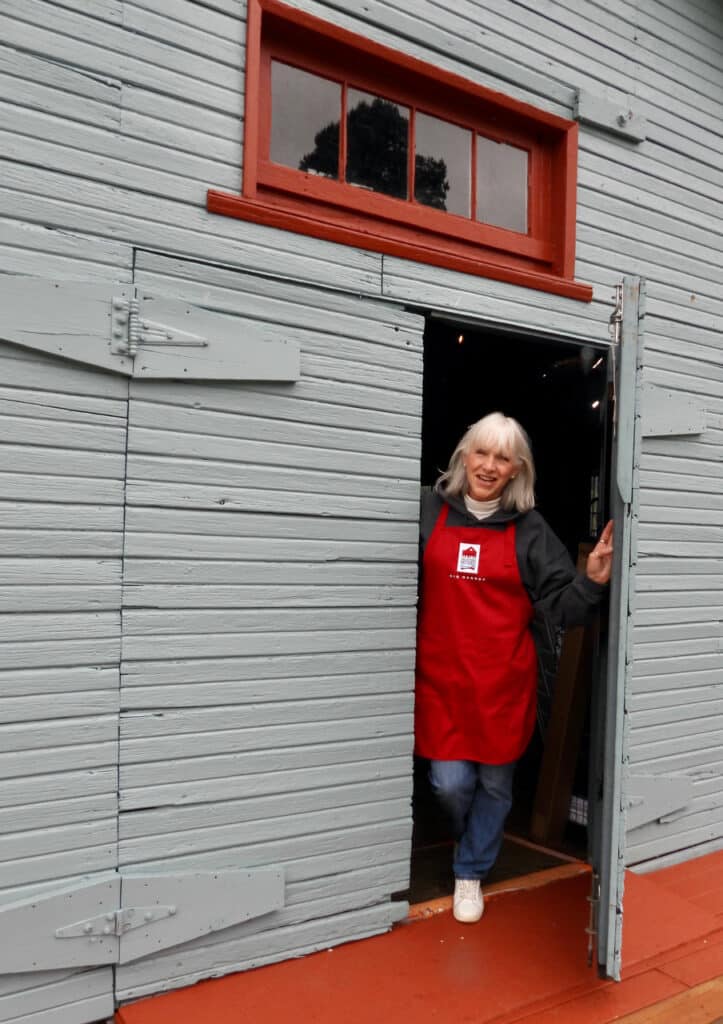
Lita Dawn Ancich at Skansie Netshed. Photo by Chapin Day
The foundation’s “Mission Statement”:
“An educational organization dedicated to the preservation of Skansie Netshed and the advancement of fishing family heritage as it exists in the people, places, vessels, skills, and stories of Gig Harbor’s commercial fishing industry.”
Ancich notes the foundation’s link to prior, sporadic “Croatia Day” celebrations. Zoran Milanovic, then the prime minister of Croatia and now its president, unexpectedly attended one in 2014.
According to a Tacoma newspaper story, Milanovic, in the Northwest on a diplomatic tour of high tech sites, chanced into word of the “Croatian Day” event and essentially dropped by Gig Harbor, a place previously unknown to him.
“First,” he said to a rapt, excited and charmed crowd, “I didn’t know you exist. Second, the only thing I was fully aware of was the sinister bridge around there.”
Ancich was active in arranging that Milanovic visit. As of last week, the highest-ranking politician scheduled to attend this Saturday’s fest is city Mayor Mary Barber.
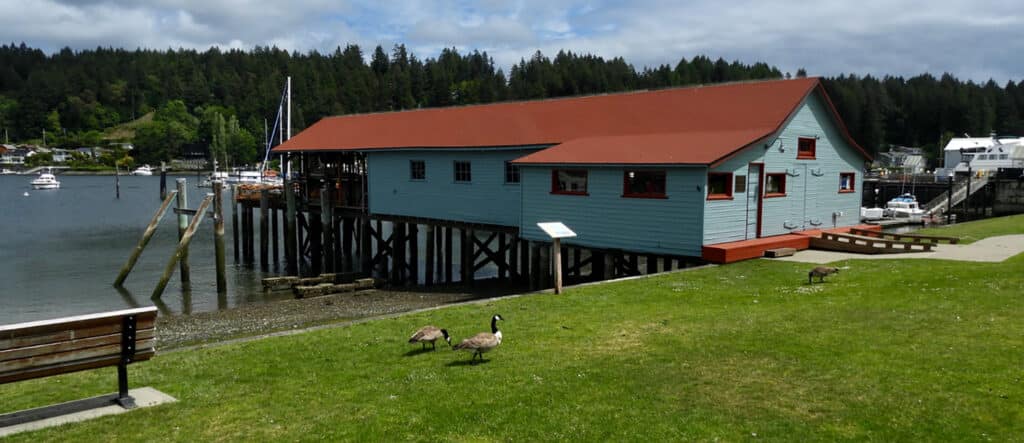
The refurbished Skansie Netshed reopens during a Croatia Day celebration on Saturday, May 31. Photo by Chapin Day
A changing waterfront
At 72, Ancich is old enough to have seen the harbor’s fishing fleet at its peak and to witness its continuing — as she sensitively calls it — “transition to other waterfront uses.”
She notes that a 2020 netshed foundation report counted that just seven of the 17 remaining city registered netsheds were still used by the commercial fishing industry.
“Now,” she says, “there are just four.”
Of the other remaining privately owned netsheds, a few house businesses while others serve as owners’ retreats or for storage and moorage.
Only the Skansie shed, a star tourist attraction in our maritime village, is owned by the people of Gig Harbor.
Gig Harbor Now asked Skansie Netshed Foundation board member Shilley what, other than a fun time, she hopes visitors to Saturday’s event will experience.
“I hope they get an education about our heritage,” she said. “I want them to understand how hard we worked.”
Croatia Day schedule
Here’s the schedule for Saturday’s events:
Noon: Pre-recorded festive Croatian music
12:30 p.m.: Welcome speakers, including Mayor Mary Barber and representatives from the Skansie Netshed Foundation and Gig Harbor Downtown Waterfront Alliance
1 to 3 p.m.: Performances by Vela Luka Croatian Dance Ensemble, Bonaca and Ruže Dalmatinke
3:30 to 5 p.m. Performances by Seattle Junior Tamburitzans, Kišobran and folkdance lesson by John Morovich
5 to 6 p.m.: Pre-recorded festive music
Summer 2025 netshed schedule
Grand-Reopening Event: Noon to 6 p.m. Saturday, May 31
June into September: open from 1 to 6 p.m. Thursdays during the Waterfront Farmers Market and from 11 a.m. to 4 p.m. Saturdays and Sundays
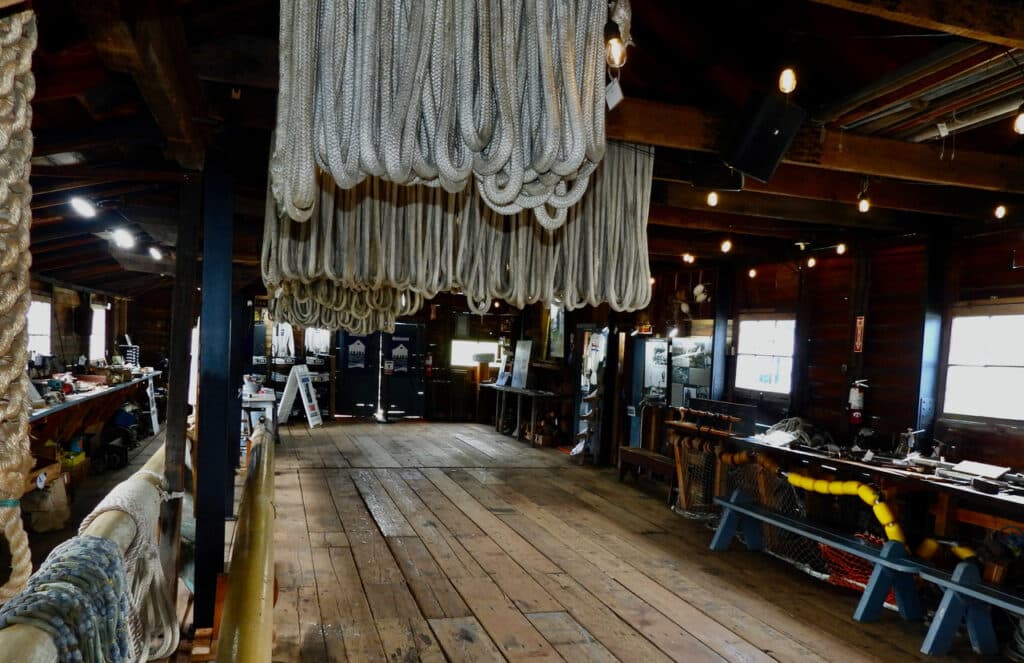
Gear on display inside Skansie Netshed. Photo by Chapin Day


